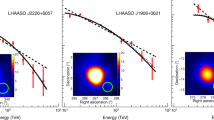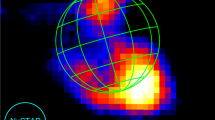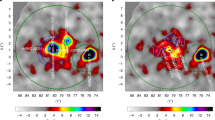Abstract
THE problem of establishing the primary cosmic-ray energy spectrum at energies ≳ 1015 eV, a region of great astrophysical interest, depends for its solution on the relation between the size and total primary energy of extensive air showers. This is because the experimental data are directly related to extensive air shower size spectra, which must then be converted to a primary energy spectrum. The necessary conversion depends, among other things, on the physics of the hadronic part of the cascade and on the primary composition in an energy region in which such information is only available from extensive air showers themselves. The primary energy spectrum above 1015 eV is thus less well established than it is, for example, below 1012 eV, where direct measurements have been made, both of cosmic-ray primaries and of individual hadronic interactions.
This is a preview of subscription content, access via your institution
Access options
Subscribe to this journal
Receive 51 print issues and online access
$199.00 per year
only $3.90 per issue
Buy this article
- Purchase on Springer Link
- Instant access to full article PDF
Prices may be subject to local taxes which are calculated during checkout
Similar content being viewed by others
References
Gaisser, T. K., and Maurer, R. H., Phys. Lett. 42 B, 444 (1972).
Gaisser, T. K., Maurer, R. H., and Noble, C. J., Proc. 13th int. Conf. Cosmic Rays, Denver, 4, 2652 (1973).
Fishbane, P. M., Gaisser, T. K., Maurer, R. H., and Trefil, J. S., The Physical Review (in the press).
Wdowczyk, J., and Wolfendale, A. W., Proc. 13th int. Conf. Cosmic Rays, Denver, 3, 2336 (1973).
Bradt, H. et al., Proc. 9th int. Conf. Cosmic Rays, London, 2, 715 (1965).
LaPointe, M. et al., Can. J. Phys., 46, 568 (1968).
Aguirre, C. et al., Proc. 13th int. Conf. Cosmic Rays, Denver, 4, 2598 (1973).
Feynman, R. P., Phys. Rev. Lett., 23, 1415 (1969).
Fishbane, P. M., Trefil, J. S., and Newmeyer, J. L., Phys. Rev., D 7, 3324 (1973).
Sreekantan, B. V., Space Sci. Rev., 14, 103 (1972).
Ormes, J. F., and Balasubrahmanyan, V. K., Nature phys. Sci., 241, 95 (1973).
Ryan, M. J., Ormes, J. F., and Balasubrahmanyan, V. K., Phys. Rev. Lett., 28, 985 and E1497 (1972).
Ramaty, R., Balasubrahmanyan, V. K., and Ormes, J. F., Science, N.Y., 180, 731 (1973).
Author information
Authors and Affiliations
Rights and permissions
About this article
Cite this article
GAISSER, T. Cosmic-ray energy spectrum from 1015 to 1018 eV. Nature 248, 122–124 (1974). https://doi.org/10.1038/248122a0
Received:
Issue Date:
DOI: https://doi.org/10.1038/248122a0
This article is cited by
-
Characteristics of primary cosmic rays and ultra-high-energy interactions from multiple muon data
Il Nuovo Cimento A (1975)
Comments
By submitting a comment you agree to abide by our Terms and Community Guidelines. If you find something abusive or that does not comply with our terms or guidelines please flag it as inappropriate.



